Page 345 of 561

344 OperationAt the gas stationCoolant
For normal replenishing, use water (pota-
ble water quality). For more information,
see “Coolant level” (
�page 351) and
“Fuels, coolants, lubricants, etc.”
(
�page 521).
Brake fluidWindshield / rear window washer
system and headlamp cleaning
system*
For more information on refilling the reser-
voir, see “Windshield / rear window washer
system and headlamp cleaning system*”
(
�page 352).
Vehicle lighting
Check function and cleanliness. For infor-
mation on replacing light bulbs, see “Re-
placing bulbs” (
�page 465).
For more information, see “Exterior lamp
switch” (
�page 147).
Tire inflation pressure
For more information, see “Checking tire
inflation pressure” (
�page 365).
!If you find that the brake fluid in the
brake fluid reservoir has fallen to the
minimum mark or below, have the
brake system checked for brake pad
thickness and leaks immediately. Noti-
fy an authorized Mercedes-Benz Light
Truck Center immediately. Do not add
brake fluid as this will not solve the
problem. For more information, see
“Brake fluid” (
�page 523).
Page 346 of 561
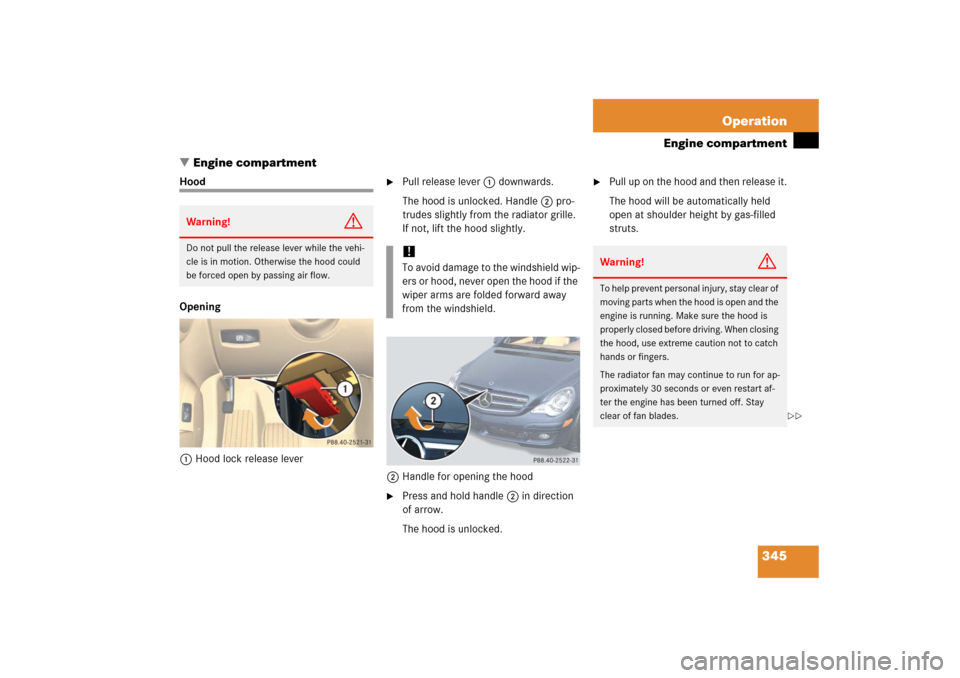
345 Operation
Engine compartment
�Engine compartment
Hood
Opening
1Hood lock release lever
�
Pull release lever1 downwards.
The hood is unlocked. Handle2 pro-
trudes slightly from the radiator grille.
If not, lift the hood slightly.
2Handle for opening the hood
�
Press and hold handle2 in direction
of arrow.
The hood is unlocked.
�
Pull up on the hood and then release it.
The hood will be automatically held
open at shoulder height by gas-filled
struts.
Warning!
G
Do not pull the release lever while the vehi-
cle is in motion. Otherwise the hood could
be forced open by passing air flow.
!To avoid damage to the windshield wip-
ers or hood, never open the hood if the
wiper arms are folded forward away
from the windshield.
Warning!
G
To help prevent personal injury, stay clear of
moving parts when the hood is open and the
engine is running. Make sure the hood is
properly closed before driving. When closing
the hood, use extreme caution not to catch
hands or fingers.
The radiator fan may continue to run for ap-
proximately 30 seconds or even restart af-
ter the engine has been turned off. Stay
clear of fan blades.
��
Page 347 of 561
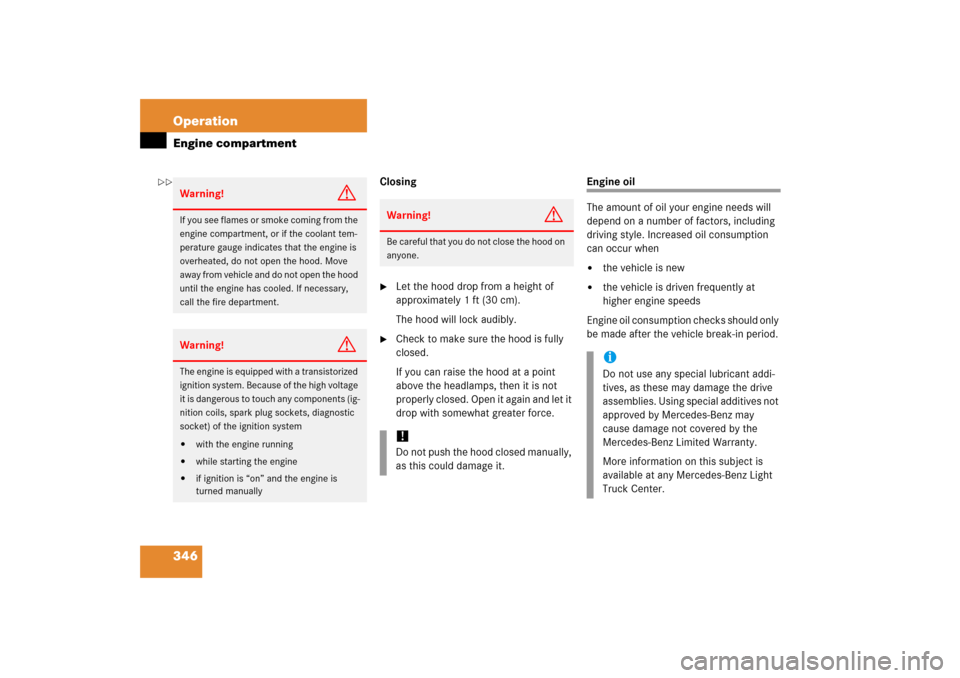
346 OperationEngine compartment
Closing�
Let the hood drop from a height of
approximately 1 ft (30 cm).
The hood will lock audibly.
�
Check to make sure the hood is fully
closed.
If you can raise the hood at a point
above the headlamps, then it is not
properly closed. Open it again and let it
drop with somewhat greater force.
Engine oil
The amount of oil your engine needs will
depend on a number of factors, including
driving style. Increased oil consumption
can occur when�
the vehicle is new
�
the vehicle is driven frequently at
higher engine speeds
Engine oil consumption checks should only
be made after the vehicle break-in period.
Warning!
G
If you see flames or smoke coming from the
engine compartment, or if the coolant tem-
perature gauge indicates that the engine is
overheated, do not open the hood. Move
away from vehicle and do not open the hood
until the engine has cooled. If necessary,
call the fire department.Warning!
G
The engine is equipped with a transistorized
ignition system. Because of the high voltage
it is dangerous to touch any components (ig-
nition coils, spark plug sockets, diagnostic
socket) of the ignition system�
with the engine running
�
while starting the engine
�
if ignition is “on” and the engine is
turned manually
Warning!
G
Be careful that you do not close the hood on
anyone.!Do not push the hood closed manually,
as this could damage it.
iDo not use any special lubricant addi-
tives, as these may damage the drive
assemblies. Using special additives not
approved by Mercedes-Benz may
cause damage not covered by the
Mercedes-Benz Limited Warranty.
More information on this subject is
available at any Mercedes-Benz Light
Truck Center.
��
Page 349 of 561

348 OperationEngine compartmentIf you see the message:Observe waiting period�
If engine is at operating temperature,
wait 5 minutes before repeating check
procedure.
�
If engine is not at operating tempera-
ture, wait 30 minutes before repeating
check procedure.
If you see the message:
Engine oil level
Not when engine on�
Turn off the engine.
�
If the engine is at operating tempera-
ture, wait 5 minutes before checking
oil.
�
If the engine is not at operating temper-
ature yet, you must wait 30 minutes
before checking oil.If there is excess engine oil with the engine
at operating temperature, the following
message will appear:
Engine oil level
Reduce oil level�
Have excess oil siphoned or drained
off. Contact an authorized
Mercedes-Benz Light Truck Center.
For more information on messages in the
display concerning engine oil, see the
“Practical hints” section (
�page 437).Checking engine oil level with the oil
dipstick (R 350 only)
When checking the oil level
�
the vehicle must be parked on level
ground
�
with the engine at operating tempera-
ture, the vehicle must have been
stationary for at least 5 minutes with
the engine turned off
�
with the engine not at operating tem-
perature yet, the vehicle also must
have been stationary for at least
5 minutes with the engine turned off
!Excess oil must be siphoned or drained
off. It could cause damage to the
engine and catalytic converter not
covered by the Mercedes-Benz Limited
Warranty.
Page 350 of 561
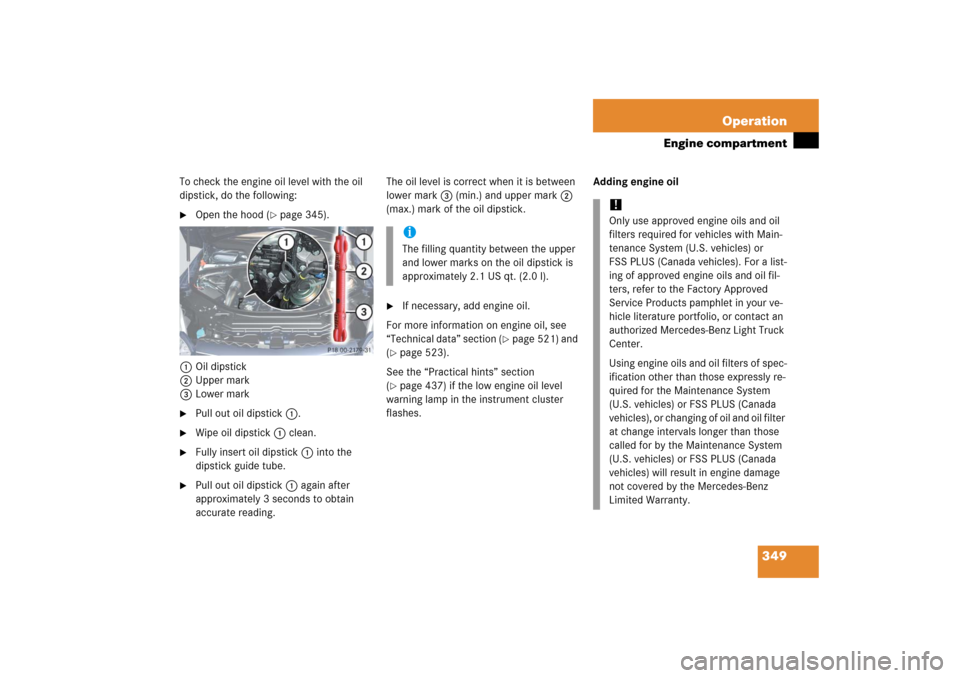
349 Operation
Engine compartment
To check the engine oil level with the oil
dipstick, do the following:�
Open the hood (
�page 345).
1Oil dipstick
2Upper mark
3Lower mark
�
Pull out oil dipstick1.
�
Wipe oil dipstick 1 clean.
�
Fully insert oil dipstick1 into the
dipstick guide tube.
�
Pull out oil dipstick1 again after
approximately 3 seconds to obtain
accurate reading.The oil level is correct when it is between
lower mark 3 (min.) and upper mark 2
(max.) mark of the oil dipstick.
�
If necessary, add engine oil.
For more information on engine oil, see
“Technical data” section (
�page 521) and
(
�page 523).
See the “Practical hints” section
(�page 437) if the low engine oil level
warning lamp in the instrument cluster
flashes.Adding engine oiliThe filling quantity between the upper
and lower marks on the oil dipstick is
approximately 2.1 US qt. (2.0 l).
!Only use approved engine oils and oil
filters required for vehicles with Main-
tenance System (U.S. vehicles) or
FSS PLUS (Canada vehicles). For a list-
ing of approved engine oils and oil fil-
ters, refer to the Factory Approved
Service Products pamphlet in your ve-
hicle literature portfolio, or contact an
authorized Mercedes-Benz Light Truck
Center.
Using engine oils and oil filters of spec-
ification other than those expressly re-
quired for the Maintenance System
(U.S. vehicles) or FSS PLUS (Canada
vehicles), or changing of oil and oil filter
at change intervals longer than those
called for by the Maintenance System
(U.S. vehicles) or FSS PLUS (Canada
vehicles) will result in engine damage
not covered by the Mercedes-Benz
Limited Warranty.
Page 351 of 561
350 OperationEngine compartmentR3501Filler capR5001Filler cap
�
Unscrew filler cap1 from filler neck.
�
Add engine oil as required. Never over-
fill with oil.
Be careful not to spill any oil when adding.
Avoid environmental damage caused by oil
entering the ground or water.
�
Screw filler cap1 back on filler neck.
For more information on engine oil, see
“Technical data” section (
�page 521) and
(
�page 523).
Transmission fluid level
The transmission fluid level does not need
to be checked. If you notice transmission
fluid loss or gear shifting malfunctions,
have an authorized Mercedes-Benz Light
Truck Center check the automatic trans-
mission.
!Excess oil must be siphoned or drained
off. It will cause damage to the engine
and catalytic converter not covered by
the Mercedes-Benz Limited Warranty.
Page 354 of 561
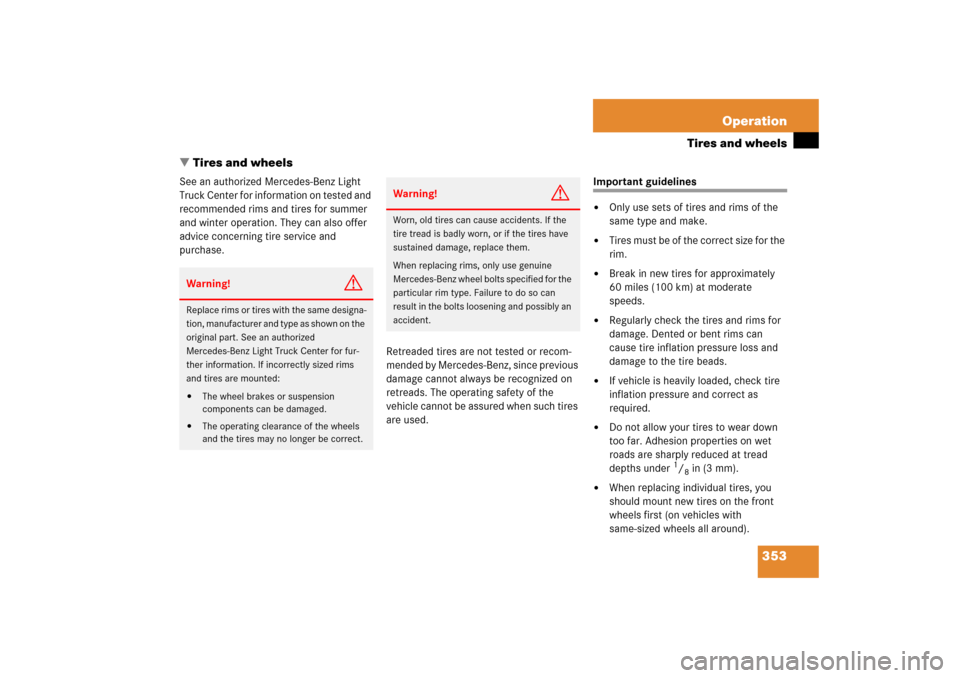
353 Operation
Tires and wheels
�Tires and wheels
See an authorized Mercedes-Benz Light
Truck Center for information on tested and
recommended rims and tires for summer
and winter operation. They can also offer
advice concerning tire service and
purchase.
Retreaded tires are not tested or recom-
mended by Mercedes-Benz, since previous
damage cannot always be recognized on
retreads. The operating safety of the
vehicle cannot be assured when such tires
are used.
Important guidelines�
Only use sets of tires and rims of the
same type and make.
�
Tires must be of the correct size for the
rim.
�
Break in new tires for approximately
60 miles (100 km) at moderate
speeds.
�
Regularly check the tires and rims for
damage. Dented or bent rims can
cause tire inflation pressure loss and
damage to the tire beads.
�
If vehicle is heavily loaded, check tire
inflation pressure and correct as
required.
�
Do not allow your tires to wear down
too far. Adhesion properties on wet
roads are sharply reduced at tread
depths under
1/8in (3 mm).
�
When replacing individual tires, you
should mount new tires on the front
wheels first (on vehicles with
same-sized wheels all around).
Warning!
G
Replace rims or tires with the same designa-
tion, manufacturer and type as shown on the
original part. See an authorized
Mercedes-Benz Light Truck Center for fur-
ther information. If incorrectly sized rims
and tires are mounted:�
The wheel brakes or suspension
components can be damaged.
�
The operating clearance of the wheels
and the tires may no longer be correct.
Warning!
G
Worn, old tires can cause accidents. If the
tire tread is badly worn, or if the tires have
sustained damage, replace them.
When replacing rims, only use genuine
Mercedes-Benz wheel bolts specified for the
particular rim type. Failure to do so can
result in the bolts loosening and possibly an
accident.
Page 356 of 561
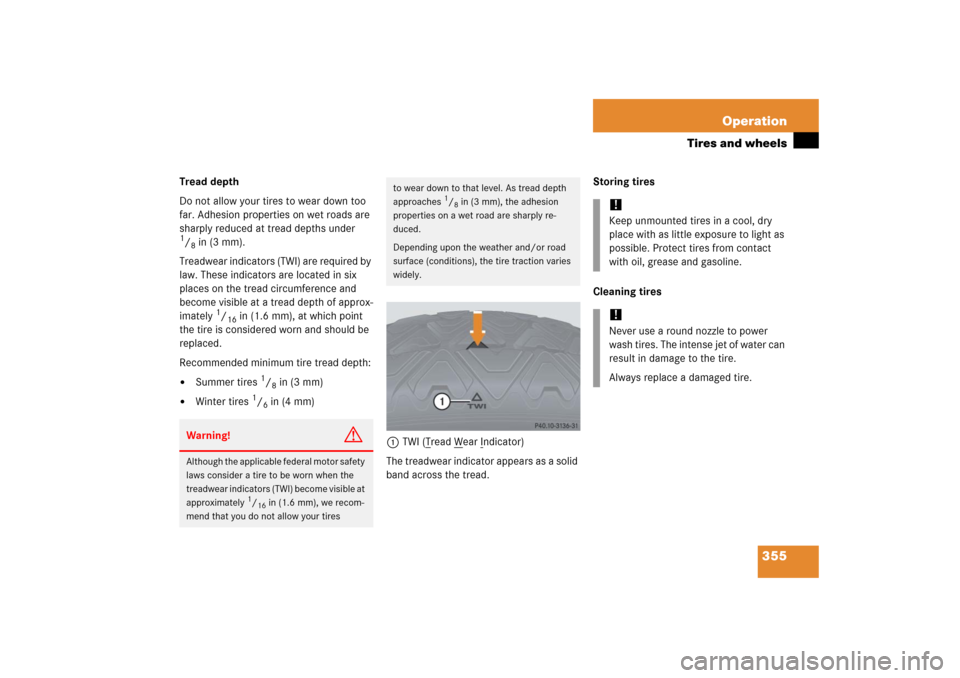
355 Operation
Tires and wheels
Tread depth
Do not allow your tires to wear down too
far. Adhesion properties on wet roads are
sharply reduced at tread depths under 1/8in (3 mm).
Treadwear indicators (TWI) are required by
law. These indicators are located in six
places on the tread circumference and
become visible at a tread depth of approx-
imately
1/16
in (1.6 mm), at which point
the tire is considered worn and should be
replaced.
Recommended minimum tire tread depth:
�
Summer tires
1/8in (3 mm)
�
Winter tires
1/6in (4 mm)
1TWI (T
read W
ear I
ndicator)
The treadwear indicator appears as a solid
band across the tread.Storing tires
Cleaning tires
Warning!
G
Although the applicable federal motor safety
laws consider a tire to be worn when the
treadwear indicators (TWI) become visible at
approximately
1/16in (1.6 mm), we recom-
mend that you do not allow your tires
to wear down to that level. As tread depth
approaches
1/8in (3 mm), the adhesion
properties on a wet road are sharply re-
duced.
Depending upon the weather and/or road
surface (conditions), the tire traction varies
widely.
!Keep unmounted tires in a cool, dry
place with as little exposure to light as
possible. Protect tires from contact
with oil, grease and gasoline.!Never use a round nozzle to power
wash tires. The intense jet of water can
result in damage to the tire.
Always replace a damaged tire.